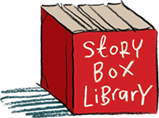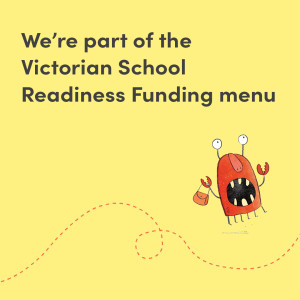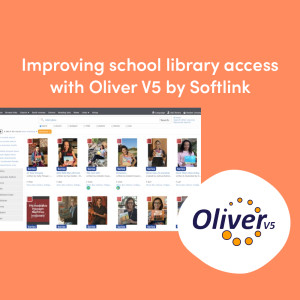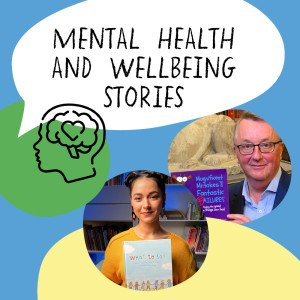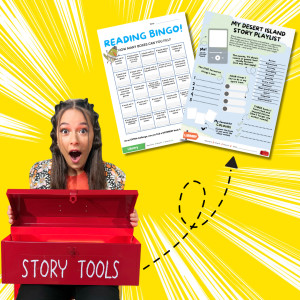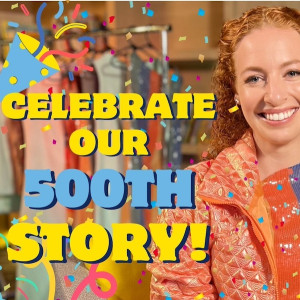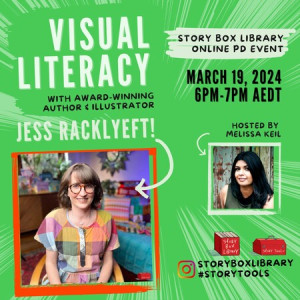Upcoming Auslan story releases
25 May 2021
Story Box Library (SBL) is committed to improving accessibility to stories for all children. That’s why we will be releasing 13 stories in Auslan, the official sign language of the Australian deaf community. Thanks to a successful grant from Telematics Trust, and creative partner Auslan consultancy, SBL will be releasing key titles with Auslan translations in July and August 2021. Twelve of these stories have been chosen for their inclusion in the CBCA Shortlist from Early Childhood and Picture Book categories.
With the increase of Auslan being taught in some schools as the chosen LOTE (Language Other Than English), SBL is excited to align with Australia curricula and improve access to education, with dynamic and diverse storytelling. Historically, Auslan education resources for children have been less available than those for hearing students. SBL’s incorporation of stories, diverse storytellers, accessible features such as closed-captions, and new Auslan translations, helps to bridge the gap in hearing privilege throughout education and resources, for young children. SBL story reads provide prominence to the Auslan interpreters, levelling the language’s importance alongside spoken languages such as English.
SBL stands by Deaf Australia’s recognition that Deaf people in Australia are disadvantaged by a lack of access to communication, education and services. The addition of Auslan-interpreted content to SBL will see families with a deaf or hearing imparied children able to access a suitable and growing resource for free through their local subscribing library, and schools and libraries able to offer a wider range of tools to their students and patrons with diverse accessibility needs. The translated stories and Activity Time videos will only be the start of SBL’s ongoing commitment to addressing this disadvantage, as we work towards equal opportunity and full participation in the community for Deaf people.
"SBL’s focus on diversity and accessibility makes it invaluable service. Their ongoing, carefully curated range of voices, ages, gender and backgrounds, complemented by closed captions for each story, demonstrates a commitment to offering everyone the opportunity to engage in stories.
SBL recognises that deaf and hard of hearing children should also have access to stories delivered in their natural language, Auslan."
Margaret Trope, Principal
Victorian College of the Deaf
Story Box Library’s Auslan story releases
All Anemone wants is a friend, but friends are hard to make when you accidentally sting everyone who comes near you.
Written and illustrated by Anna McGregor, read by Mel Buttle for Melbourne Writers’ Festival.
From author, illustrator and storyteller Sarah Allen, Busy Beaks is full of splashing shorebirds, clattering cockatoos, parading penguins and greedy galahs, Busy Beaks is the perfect introduction to Australian birds of all shapes and sizes.
Georgie is a sweet little girl who always makes her parents happy... until she discovers one powerful phrase: No! Never!
Written by Libby Hathorn and Lisa Hathorn-Jarman, illustrated by Mel Pearce, and read by New Zealander Michala Banas.
It wasn't a hungry giant or a blood-sucking spider or a fire-breathing dragon because there is NO SUCH THING…
Is there?
Written and illustrated by Heidi McKinnon and read by Captain Starlight, from the Starlight Foundation.
Magoo has his own ideas about what a dog should do – in the kitchen, in the car, at dinnertime and bedtime! But there are so many rules! So many things a dog can't do.
From creator Briony Stewart, read by Michala Banas.
A beautiful story that celebrates nontraditional families and captures exactly what lies at the heart of family life — love. Gorgeously illustrated by Anna Zobel, written with a light and humorous touch by Bernadette Green, and read by Erin Wamala.
A moving story about the wonders of imagination and the nature of growing up from one of Australia’s most revered bookmakers.
Written and illustrated by Bob Graham, read by SBL Librarian Storyteller of the Year Winner 2020 and State Library Queensland librarian, Frankie Jaiyeola.
Stunning imagery and moving language let imagination take flight in an ethereal primer on making a bird. Breathe deeply and take your time. The making of a bird is not a thing to be hurried.
Written by Meg McKinlay, illustrated by Matt Ottley, read by Kate Miller-Heidke for Melbourne Writers’ Festival.
Is imitation the sincerest form of flattery? Or is it just annoying?
This irresistible read-aloud helps children deal with the sensitive topics of conformity, individuality and belonging in an accessible, kid-friendly way.
Written and illustrated by Gabriel Evans, read by SBL Librarian Storyteller of the Year Winner 2020 and State Library Queensland librarian, Frankie Jaiyeola.
This is the romping, stomping, chomping tale of one stubbornly adorable marsupial. But beneath its many costumes, Not Cute is a simple story about self-acceptance, listening to others, and not succumbing to your own delusions.
Written and illustrated by Philip Bunting, read by Mel Buttle for Melbourne Writers’ Festival.
Like all twins, Jules and George do everything together. But after a long, hot day at the beach, even twins sometimes disagree ...
From multi-award-winning picture book creator Freya Blackwood comes a cheeky and charming story about the ups and downs of sibling love. Read by Alice Pung, for Melbourne Writers’ Festival.
The story of a plucky young cockroach who gate-crashes a birthday party – with hilarious results. Funny, silly and surprisingly cute, Your Birthday Was the Best! is the perfect blend of downright gross and delightfully entertaining. Written by Maggie Hutchings, illustrated by Felicita Sala and read by Wayne Hope.
Set in the rugged Australian bush, this story is about a small calf who becomes separated from his family, who have been taken away in the back of a noisy truck. So begins the little calf’s journey to find them again. Written by Bruce Pascoe, illustrated by Charmaine Ledden-Lewis, and read by Emma Donovan for Melbourne Writers’ Festival.
"SBL are great advocates for accessibility, recognise the shortage of teachers and interpreters and by developing this Auslan tailored content, they would ensure that Auslan is more widely available, for both the hearing world and supporting the inclusion of the Deaf community.”
Vicki Main, Assistant Principal
Aurora School
Supporting partners and thanks
With the support of the Telematics Trust, working in conjunction with the Victorian College for the Deaf and with the support of Australian publishing houses, SBL is making an important move with the level of attention and dedication it requires to work towards a more inclusive future. SBL wishes to thank the following children’s book authors, illustrators and publishers, creative partners, and letters of support provided by organisations:
Children’s book authors and illustrators for the inclusion of their books in this series, Anna McGregor, Sarah Allen, Libby Hathorn, Lisa Hathorn-Jarman, Mel Pearce, Heidi McKinnon, Briony Stewart, Anna Zobel, Bernadette Green, Bob Graham, Meg McKinlay, Matt Ottley, Gabriel Evans, Philip Bunting, Freya Blackwood, Maggie Hutchings, Felicita Sala, Bruce Pascoe, Charmaine Ledden-Lewis.
Publishers Scribe, Affirm Press, Hachette Australia, Allen & Unwin, Penguin Books, Scribble, Walker Books, Simon & Schuster, Scholastic Australia, Harper Collins Australia, Magabala Books.
Letters of support from Allen & Unwin Publishers, Aurora School, Furlong Park School for Deaf Children, Victorian College of the Deaf.
Facts about Auslan:
The Australian Federal Government recognised Auslan (Australian Sign Language) as a language in 1987.
Auslan uses two-handed signs and incorporates a two-handed alphabet (fingerspelling).
While Auslan is less fixed grammatically, when compared to the English language, it still uses some rules and conventions.
Auslan structure includes H O L M E: handshape, orientation, location, movement and expression.
The first Auslan dictionary was published in 1989.
Source: https://deafnav.com.au/understand/communication/auslan
To learn more about using Story Box Library as a tool for inclusive language learning and audio-visual support, visit our resources page.
